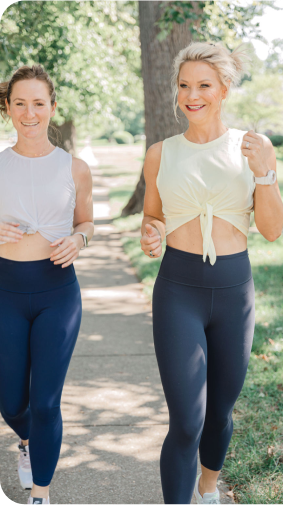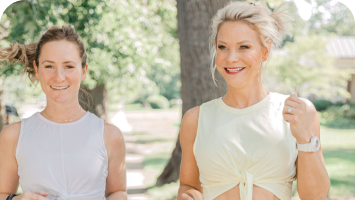Walking is our favorite form of exercise in the United States. And for good reason: it’s simple, accessible, and effective. Taking walks, even for just 11 minutes a day, significantly lowers the risk of heart disease, many kinds of cancer, and mortality overall.
Walking has huge benefits for minor effort. One of the best forms of preventative medicine is as easy as putting one foot in front of the other.
But if your goal is weight loss, shouldn’t you pick up the pace? Not necessarily. There are simple ways to increase intensity without turning your stroll into a struggle. Here’s how to walk your way to weight loss.
Walk the Right Amount Per Week
How many miles do you have to put behind you to drop pounds? To lose weight, aim to walk at least 30 minutes a day, 5 days a week. Here are some details to help you find your goal:
How much weight you can lose by walking depends on your current weight, diet, and activity level. Generally, however, walking 1 mile burns 80-100 calories. To lose 1 pound of body fat, your body will need to burn 3,500 calories (about 35 miles, or 70,000 steps).
Hit your 10,000 steps a day goal, and you’ll drop about a pound of body fat behind each week.
Strap on a Pedometer
10,000 daily steps (or 5 miles) a day might sound intimidating. But even a 2-mile walk can give you the step boost you need to reach your end goal.
That’s where a pedometer comes in handy. You’ll see that adding a little movement throughout the day really adds up. Walking around your house, to and from your car, up and down stairs, or pacing at work can be the small lifestyle shift that you need to lose weight just through walking.
Pick Up the Pace
A skip in your step will help you slim down. While walking brings benefits no matter your speed, increasing your pace will push your weight loss to another level. Check out these numbers:
A 154-pound person burns 280 calories an hour walking at a moderate pace (3.5 miles per hour). By increasing their pace to vigorous (4.5 miles per hours), that same person will burn 460 calories an hour.
If you want to fast-track your weight loss, put on some pump-up music, and hit the pavement.
Invite Your Arms to Join In
Engaging your glutes and quads during a walk burns big calories. These muscle groups are some of the largest in our bodies, but we can increase the burn by adding upper body movement too.
Bring along very light weights to hold, or carry a water bottle in each hand. Complete curls or shoulder presses, or pump your arms while you walk.
Leverage the Landscape
Take the hard route. When you see a hill, take on the challenge! When you come across a bench, complete a few step-ups. If you pass a parking block, stop and do 15 calf raises. While waiting at a stoplight, complete 20 squats and lunges.
Adding body weight strength movements or walking uphill also does wonders for your metabolism. While cardio workouts alone (like briskly walking on a flat surface) burns calories in the moment, strength movements keep your body burning more calories long after your walk is over.
Think of your walk as an opportunity to raise your heart rate, break a sweat, build your endurance, and boost your metabolism. Whenever you can, give your muscles a challenge. If you’re dedicating a half hour each day to this walk, make it count!
Focus on Good Form
While walking, make sure you’re maintaining proper form and posture. Looking forward can help you engage your abs, lengthen your stride, and increase your speed.
Check in regularly with your body, noting if you’re leaning forward or slouching. Try to keep your core engaged, tighten your abdominal muscles, and engage your glutes with each step.
This technique can help you burn more calories on your walk and stay injury-free so you can keep walking for years to come.
Split Your Stroll
If you can’t commit to one 30-minute walk a day, don’t give up, split it up. Three ten-minute walks or two fifteen-minute walks might fit your schedule better. You’ll still boost your health and drop pounds.
Splitting up your walk might even be healthiest. According to one study on inactive people over 60 years old, walking for 15 minutes three times a day after meals helped the the participants control blood sugar levels better than walking once a day for 45 minutes.
Balancing your blood sugar will make weight loss easier too. When your blood sugar is balanced, your body will store less fat from the food you eat, and your cravings will be more manageable.
Don’t Get Caught Up on Gadgets
When we start a new exercise routine, it’s easy to believe we have to buy a new kit of gear and gizmos. Walking, however, doesn’t require anything but the clothes on your back.
While a pedometer can help you keep track, most phones track steps too. There’s no need to hesitate before you hit the road. You have everything you need, today, to start walking.
You Won’t Lose Weight By Walking Unless…
Exercise is only 20% of the weight loss journey. What you put in your mouth matters a lot more. In order to shed pounds, burn body fat, and keep weight off, you have to eat right.
If you don’t know where to start with your diet, you’re in a good place. I’ll teach you how to stop overeating, how to read nutrition labels, and even the best pasta brands for weight loss.
This week, let walking support your weight loss journey. You’ll find that after your stroll, you’re much more likely to hit your water goals, cravings will decrease, and weight loss will get easier.





